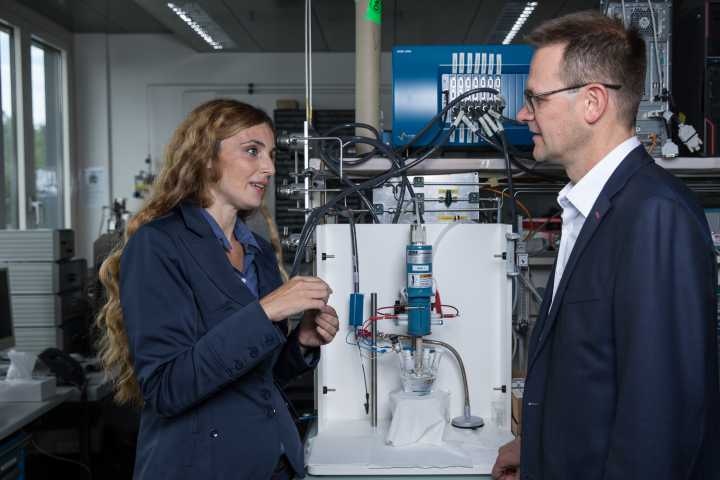Jul 18 2017
 The scientists Emiliana Fabbri and Thomas Schmidt in a lab at PSI where they conducted experiments to study the performance of the newly developed catalyst for electrolysers. (Photo: Paul Scherrer Institute/Mahir Dzambegovic)
The scientists Emiliana Fabbri and Thomas Schmidt in a lab at PSI where they conducted experiments to study the performance of the newly developed catalyst for electrolysers. (Photo: Paul Scherrer Institute/Mahir Dzambegovic)
Storage technologies that are efficient are considered to be essential if wind and solar energy is to help meet the increased energy demands. One vital approach refers to storage in the form of hydrogen extracted from water by using solar or wind energy.
This process occurs in an electrolyzer. These devices are likely to become more efficient and cheaper in the future because of a new material produced by researchers at the Paul Scherrer Institute PSI and Empa. The material in question functions as a catalyst accelerating the splitting of water molecules: the initial step in hydrogen production. Researchers also demonstrated that this new material can be produced in a reliable manner in huge quantities and also showed the material’s performance potential within a technical electrolysis cell, which is the key component of an electrolyzer. The research outcomes have been published in the recent edition of Nature Materials, a scientific journal.
Solar and wind energy will only contribute majorly to meeting energy demands once a reliable storage method has been developed since this energy is not always available. Storage in the form of hydrogen is one potential approach to this problem. This process needs an electrolyzer, which utilizes electricity produced by solar or wind energy in order to split water into oxygen and hydrogen. Hydrogen is used as an energy carrier. It is possible to store hydrogen in tanks and later convert it back into electrical energy by using fuel cells. This process can be performed locally, in places where energy is required such as fuel cell vehicles or domestic residences, allowing mobility without the emission of CO2.
Inexpensive and efficient
Researchers at the Paul Scherrer Institute PSI have presently developed a new material functioning as a catalyst inside an electrolyzer and thus accelerating the splitting of water molecules: the initial step in the production of hydrogen.
There are currently two types of electrolysers on the market: one is efficient but expensive because its catalysts contain noble metals such as iridium. The others are cheaper but less efficient. We wanted to develop an efficient but less expensive catalyst that worked without using noble metals.
Emiliana Fabbri, Researcher, Paul Scherrer Institute
Researchers explored this procedure and were able to use a material that had previously been developed, a so-called perovskite, which is an intricate compound of the elements oxygen, iron, cobalt, strontium and barium. However, they were the very first to come up with a technique allowing its production in the form of miniscule nanoparticles. This indeed is the form that will enable it to function effectively since a catalyst needs a bigger surface area on which several reactive centers are able to accelerate the electrochemical reaction. After individual catalyst particles are produced as small as possible, their respective surfaces merge and produce a much bigger overall surface area.
A so-called flame-spray device was used by researchers in order to produce this nanopowder: a device managed by Empa that sends the constituent parts of the material via a flame where they combine and rapidly solidify into tiny particles once they leave the flame.
We had to find a way of operating the device that reliably guaranteed the solidifying of the atoms of the various elements in the right structure. We were also able to vary the oxygen content where necessary, enabling the production of different material variants.
Emiliana Fabbri, Researcher, Paul Scherrer Institute
Successful Field Tests
Researchers succeeded in demonstrating that these procedures work in practice besides working in the laboratory. The production method generates huge quantities of the catalyst powder and can also be made instantly available for industrial use. We were eager to test the catalyst in field conditions. Of course, we have test facilities at PSI capable of examining the material but its value ultimately depends upon its suitability for industrial electrolysis cells that are used in commercial electrolysers, says Fabbri. Researchers tested the catalyst in collaboration with an electrolyzer manufacturer in the US and succeeded in demonstrating that the device worked in a more reliable manner with the new PSI-produced perovskite than with a standard iridium-oxide catalyst.
Examining in Milliseconds
Researchers also succeeded in performing precise experiments that offered exact information on what takes place in the new material when it is active. This was done by analyzing the material with X-rays at PSI's Swiss Light Source SLS. This facility offers researchers with an exceptional measuring station that has the potential to analyze the condition of a material over successive timespans of only 200 ms.
This enables us to monitor changes in the catalyst during the catalytic reaction: we can observe changes in the electronic properties or the arrangement of atoms. At other facilities, each individual measurement takes about 15 minutes, providing only an averaged image at best.
Emiliana Fabbri, Researcher, Paul Scherrer Institute
These measurements also demonstrated how the structures of particle surfaces vary when active parts of the material become amorphous, meaning that the atoms in separate areas are no longer uniformly positioned. This unexpectedly enables the material to be a better catalyst.
Use in the ESI Platform
A vital aspect of the research carried out at PSI refers to the efforts being made on developing technological solutions for Switzerland's energy future. To this end, PSI makes its Energy System Integration (ESI) experimental platform available to industry and research, allowing the testing of promising solutions in different complex contexts. A significant base for the production of a new generation of water electrolyzers is provided by the new catalyst.